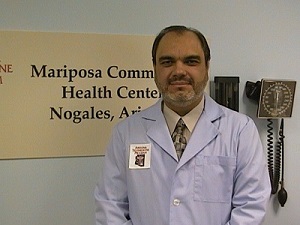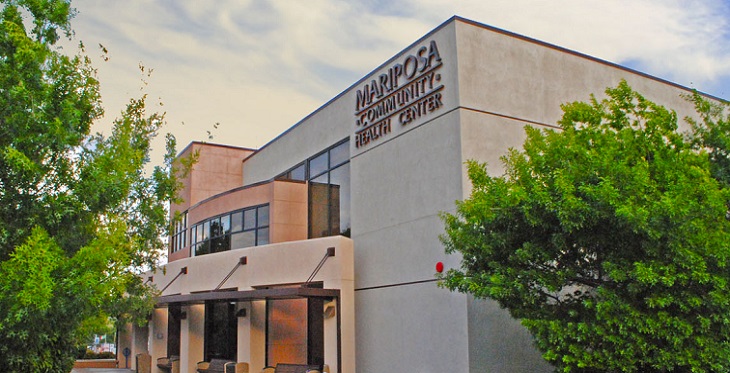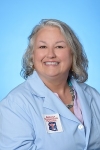As Dr. Eladio Pereira recalls the challenges he and other medical professionals experienced during Covid, an easy broad smile spreads across his face thinking about his friend the late Dr. Ron Weinstein and the crew at the Arizona Telemedicine Program.
Pereira, chief medical officer at the Mariposa Community Health Center that serves the U.S.-Mexico border communities of Santa Cruz County in Southern Arizona, said Mariposa’s Nogales clinic was one of ATP’s first telemedicine projects outside Tucson in 1997.
“We were learning together. They wanted us to participate and were extremely generous with us,” Pereira said.
The clinic designated a telemedicine room where ATP staff installed the network infrastructure and brought in the equipment needed for a telemedicine program that connected patients in the Nogales area to a rheumatology and dermatology practice in Tucson.
“We were excited. Back then Dr. Weinstein and his staff were promoting telemedicine as the future,” Pereira said. “And you know what? Now we know that they were right.”

The experience provided by Dr. Weinstein and his team ended up being a gift that helped Mariposa's transition into telemedicine during the early days of the Covid pandemic. "We did have a memory of what it was like to do telemedicine, so we were prepared. It was all because of our ATP experience and the fact that it was fantastic," he said.
As Mariposa Community Health Center, which now has five clinics in Santa Cruz County and serves about 30,000 patients a year, launched a new telemedicine service during the pandemic, Pereira said a lot of assumptions he and his colleagues had didn’t happen, or at least not as significantly as they anticipated.
For example, Pereira and his colleagues assumed patients would have internet connectivity issues, or didn’t have computers, that there would be privacy issues, or that their telephone would not be able to support a telemedicine platform.
“That turned out to be for the most part not relevant. People did have good phones most of the time, and some of them had computers. For the most part, they had connectivity,” Pereira said.
What Pereira and his colleagues ended up focusing on the most was employee workflow and the communication needed to create a positive experience for their patients.
“For many they wondered how a doctor was going to take care of me by the computer. ‘Am I able to ask questions?’ ‘Am I able to show the rash?’,” he said. For some patients who didn’t have computers, a phone or no Internet, they were able to come to one of the clinics and use a laptop to connect with a doctor if that doctor wasn’t available in person.
Pereira said about 80 percent of Mariposa’s community was able to use telemedicine at home during Covid. As the pandemic numbers have leveled off, about 20 percent of Mariposa patients now use telemedicine regularly, especially in areas like telepsychiatry.
“We managed to take care of our communities and we continue to do what we need to do. I think telemedicine is evolving. We want to do it better and better, and I think patients are realizing that telemedicine is part of what we do. In fact, some of them ask for it,” Pereira said. “We’ve had teachers reach out who only have an hour for lunch and can’t make it to the clinic. They can get to an empty classroom and talk to their doctor. Having that option is a cool thing to do, and we know it’s not for everything or everyone, but it's another way to provide needed healthcare.”
One area of care that telemedicine has proven helpful are the mandatory Medicare Annual Wellness visits that do not require physical exams, so “telemed is an excellent way of doing that. Patients can do those visits from home.”
Like other hospitals and clinics throughout the country, Mariposa has faced some doctor shortages. They recently brought in seven new providers—all with telemedicine experience. “But it’s too early to say if telemedicine will solve personnel shortages. We do know that at times a doctor may have to switch from in-person to a telemedicine appointment. We are now able to accommodate that if a patient can do the visit through telemedicine at their home or office or come to the clinic and see their doctor in one of our telemedicine rooms.”
Pereira has his own personal experiences using telemedicine beyond his professional life at Mariposa. He sees a specialist in Tucson once a year in person. Three other visits with that specialist are now done through telemedicine.
“I send him my weight, my blood pressure, and any new medications I’m taking. I get a text reminder; I click on it, and it lets me in. We're done,” he said. “That’s pretty cool.”
As Mariposa moves forward in its telemedicine development, Pereira said they are developing best practices across all clinics, but the creation of a good workflow remains a priority. Making sure a telemedicine appointment mirrors a regular visit is a good start, that the patient records are updated and examined before the visit, and that if important screenings are due, like mammogram, that they get scheduled.
“We want to minimize that gap between in-person and the telemed visit. We know we want the visit to be efficient,” Pereira said. “We want to make the visit a good one and the patient happy.”

